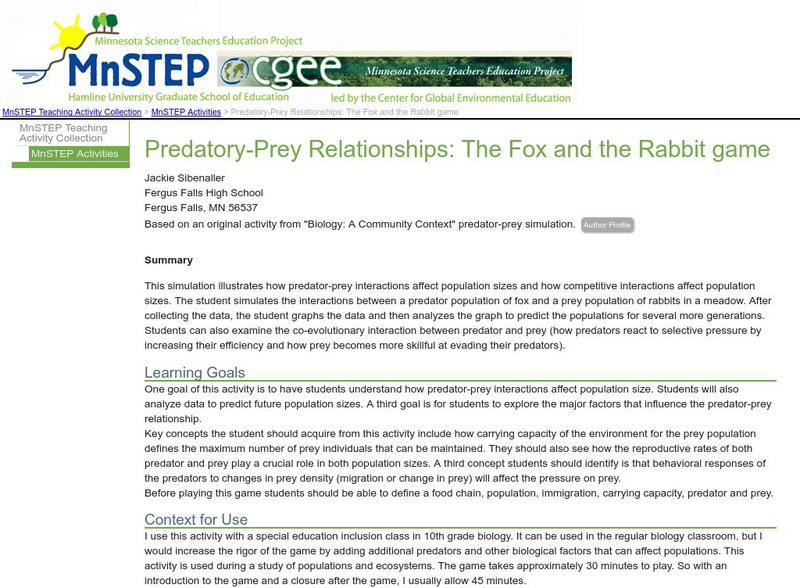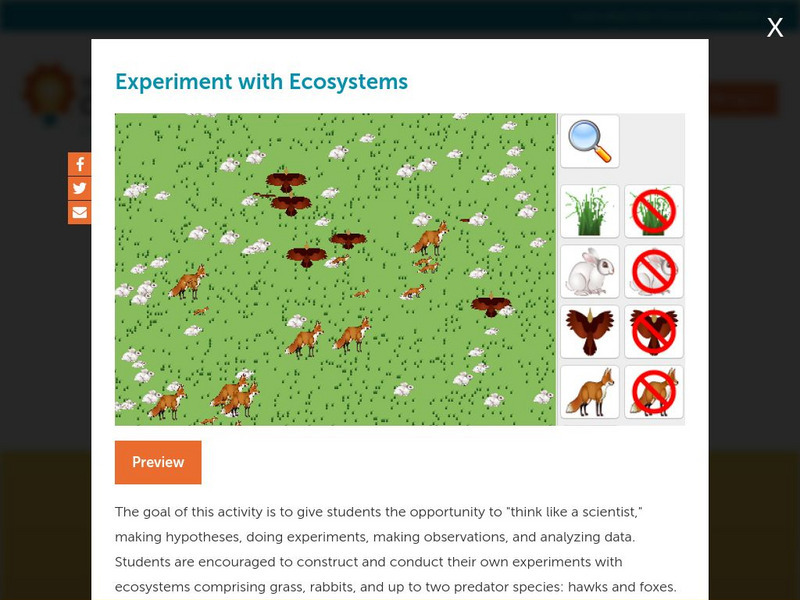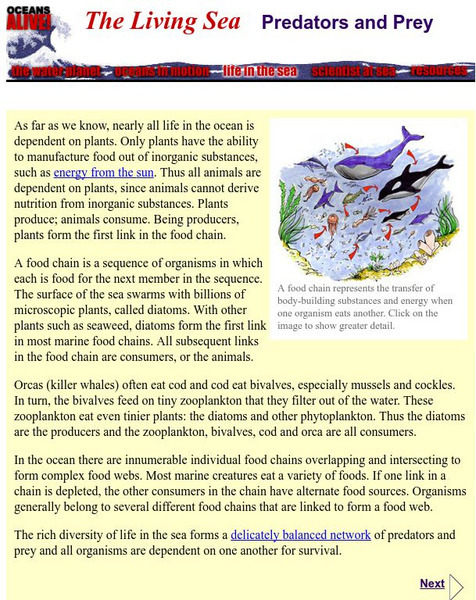Other
Kathy's Critters: Predator Prey Bottle Column
Learn how to make a predator prey column out of 2 liter bottles. You can actually see the predator find the prey!
Encyclopedia of Earth
Encyclopedia of Earth: Predation
Defines the term predation, describes the types, and explains the roles predation plays in population management, in species diversity, and in natural selection. (Published: December 28, 2009)
CK-12 Foundation
Ck 12: Life Science: 12.8 Predation
Understand the predator-prey relationship in an ecosystem.
CK-12 Foundation
Ck 12: Life Science: Predation
[Free Registration/Login may be required to access all resource tools.] Predation is another mechanism in which species interact with each other. Predation is when a predator organism feeds on another living organism or organisms, known...
PBS
Idaho Ptv: Predators
A comprehensive resource on the topic of predators. Includes half-hour video, facts, links, a reading list, resources for teachers, and a glossary, While there are links to videos, they may no longer work.
Science Education Resource Center at Carleton College
Serc: Predatory Prey Relationships: The Fox and the Rabbit Game
This activity helps students understand how predator-prey interactions affect population sizes and how competitive interactions affect population sizes. They will also explore the major factors that influence the predator-prey relationship.
CK-12 Foundation
Ck 12: Biology: Predation
[Free Registration/Login may be required to access all resource tools.] Discusses how predation affects population size and evolution.
DOGO Media
Dogo News: Scrunchies May Save Birds From Fiercest Predator
Read about a wearable device that may help prevent birds from being attacked and killed by cats. Includes video.
PBS
Pbs Learning Media: Catch Me if You Can
Students are asked to explain the predator/prey relationship and how it helps to maintain the balance of the ecosystems.
Concord Consortium
Concord Consortium: Stem Resources: Experiment With Ecosystems
Learn what happens to different populations of organisms as their ecosystem changes. Design your own experiment and make your own guesses with what the result will be with this virtual ecosystem. Also experiment with producer/consumer...
TED Talks
Ted: Ted Ed: From the Top of the Food Chain Down: Rewilding Our World
Our planet was once populated by megafauna, big top-of-the-food-chain predators that played their part in balancing our ecosystems. When those megafauna disappear, the result is a "trophic cascade," where every part of the ecosystem...
PBS
Pbs Teachers: Predator Protector Game Lesson
Describe the habitat, food web and ecosystem of shark species. Identify threats to sharks and explore how top predators help to maintain the balance of nature within ecosystems. This lesson plan also contains an interactive game.
National Geographic
National Geographic: Marine Food Webs
For this lesson, students learn about marine food webs and pyramids, and how energy flows through a marine ecosystem. They then research a marine organism and its role in a marine food web. The class pools their information to create a...
PBS
Pbs Teachers:denali: The Wolf and the Moose: Predator and Prey Relationships
Examine the predator/prey relationship between wolves and moose in Alaska's Denali National Park and discuss how the balance of nature works between these two animals.
Soft Schools
Soft Schools: Birds of Prey: Looking at Raptors Quiz
Take this interactive, multiple-choice quiz over birds of prey, then review your score and any missed questions at the end.
Museum of Science
Museum of Science: The Living Sea: Predators and Prey
This Museum of Science page does an excellent job of explaining the importance of plants as producers in the sea. The food chain or food web has to start with the plants.
TED Talks
Ted: Ted Ed: Can Animals Be Deceptive?
Eldridge Adams details the surprising complexity of how animals manipulate predators, prey and their rivals.
Ed Koday
Web Archive: Ambush Bug
Ambush bugs are predators which normally lie in wait for prey. They have front legs fitted for grasping, much like that of a praying mantis. They commonly sit on a flower waiting for insects attracted to flowers. Goldenrod is a favorite...
PBS
Pbs Kids: Plum Landing: Mangroovin'
In this game, players take on the role of baby groupers, fish who grow up in the shelter of mangrove roots. They need to swim into open water to find food without falling prey to hungry predators.
Ed Koday
Web Archive: Antlion
Have you ever heard of a "doodlebug"? Well, you're looking at one right up above! It is actually an insect called an antlion. The antlion gets its name because it is a voracious predator of ants and other insects. Actually, it's only the...
Concord Consortium
Concord Consortium: Stem Resources: Predators and Prey
Did you ever want to be a hawk? In this virtual ecosystem, students will take on the role of a hawk and try to catch rabbits on a snowy field. Students will see which rabbits have adaptations that allow them to blend into the environment...
Sea World Parks & Entertainment
Sea World: Raptors
Outlines the characteristics of birds of prey, including classification, habitat, behaviors, and conservation. Helps students identify with these birds by integrating a list of "Books for Young Readers." Information at a level of upper...
Other
Pde Sas: Relationships Among Organisms
In this lesson, students compare various types of relationships among organisms (i.e., biotic interactions). Students will: explain the roles of producers and consumers, and predators and prey in an ecosystem. Explain the levels of order...
Science Education Resource Center at Carleton College
Serc: Food Chains: Nature's Restaurant
Young scholars begin this lesson by making observations and recording evidence of the variety of living things in local nature site. Students use reference materials to research predators and food of the animals they observed, then...
Other popular searches
- Predator Prey Graph
- Predator Prey Relationships
- Predator Prey Game
- Predator Prey Parasite Host
- Predator Prey Population
- Predator and Prey Activities
- Predator Prey Cycles
- Predator and Prey Science
- Predator Prey Interactions
- Predator Prey Relationships
- Predator Prey Simulations
- Predator and Prey Balance


















